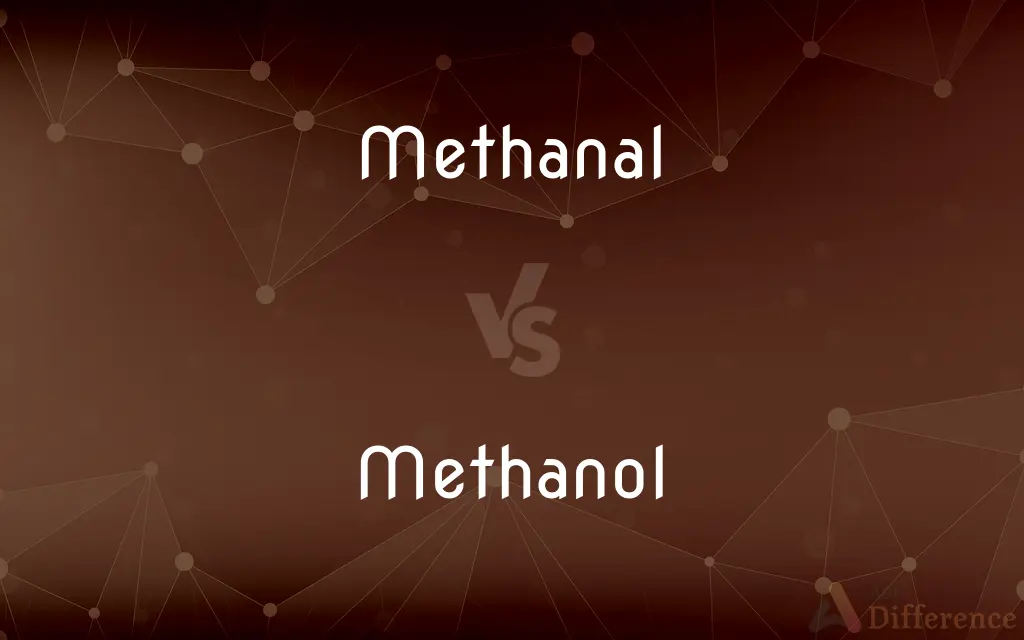Methanal vs. Methanol — What's the Difference?
Edited by Tayyaba Rehman — By Urooj Arif — Updated on February 29, 2024
Methanal, also known as formaldehyde, is a simple aldehyde used as a preservative and in chemical manufacturing, while methanol, a simple alcohol, is used as a solvent, fuel, and antifreeze agent.

Difference Between Methanal and Methanol
Table of Contents
ADVERTISEMENT
Key Differences
Methanal (formaldehyde) and methanol are both organic compounds with significant differences in their chemical structure and uses. Methanal, with the formula CH2O, is the simplest aldehyde and is characterized by its strong, pungent smell and potential health hazards, including its role as a carcinogen. It is widely used in the production of industrial resins, as a disinfectant, and in embalming fluids.
Methanol (CH3OH), on the other hand, is the simplest alcohol. It is a colorless liquid with a slightly alcoholic odor and is highly toxic if ingested. Methanol is used as a solvent, antifreeze, fuel, and as a denaturant for ethanol. It also serves as a feedstock in the production of formaldehyde and other chemicals.
The key structural difference between the two is the functional group: methanal has an aldehyde group (-CHO), while methanol has a hydroxyl group (-OH). This difference greatly affects their reactivity and the types of reactions they undergo. Methanal is more reactive due to its aldehyde group, making it useful in chemical syntheses and industrial applications.
Safety and handling of these chemicals are paramount due to their toxic nature. Methanal's toxicity is well-documented, with exposure limits set by health agencies. Methanol, while also toxic, poses risks primarily through ingestion or prolonged exposure.
Despite their dangers, both compounds are invaluable to industry. Methanal's role in producing polymers and resins is critical in automotive and construction materials, while methanol's use as a fuel additive and solvent underscores its versatility in various industrial processes.
ADVERTISEMENT
Comparison Chart
Formula
CH2O
CH3OH
Type
Aldehyde
Alcohol
Uses
Preservatives, industrial resins, disinfectants
Solvent, fuel, antifreeze, feedstock for chemicals
Toxicity
High (carcinogen)
High (toxic if ingested)
Odor
Strong, pungent
Slightly alcoholic
Key Functional Group
Aldehyde group (-CHO)
Hydroxyl group (-OH)
Reactivity
More reactive, useful in chemical syntheses
Less reactive than aldehydes
Safety Concerns
Exposure limits due to carcinogenic nature
Toxicity through ingestion or exposure
Compare with Definitions
Methanal
Methanal is a toxic aldehyde used in making industrial resins.
Urea-formaldehyde resins in particleboard.
Methanol
Methanol is a simple alcohol used as a solvent and fuel.
Methanol fuels some racing engines.
Methanal
Methanal's reactivity is harnessed in organic syntheses.
The production of polymeric materials often involves methanal.
Methanol
Methanol is highly toxic and dangerous if ingested.
Ingestion of methanol can lead to blindness or death.
Methanal
It is a potent disinfectant and preservative.
Methanal solutions preserve biological specimens.
Methanol
It serves as an antifreeze in pipelines and windshield fluid.
Methanol-based products prevent freezing in winter.
Methanal
Known for its strong, pungent smell.
The sharp odor in some industrial settings is often due to methanal.
Methanol
Used as a denaturant for ethanol.
Methanol is added to ethanol to make it unfit for consumption.
Methanal
It is carcinogenic, necessitating careful handling.
Industrial use of methanal requires stringent safety measures.
Methanol
As a chemical feedstock, it's pivotal in producing other compounds.
Methanol is converted into formaldehyde and acetic acid.
Methanal
(organic compound) The IUPAC name for formaldehyde, rarely used in research or industry.
Methanol
Methanol, also known as methyl alcohol amongst other names, is a chemical and the simplest alcohol, with the formula CH3OH (a methyl group linked to a hydroxyl group, often abbreviated MeOH). It is a light, volatile, colourless, flammable liquid with a distinctive alcoholic odour similar to that of ethanol (potable alcohol).
Methanal
Same as formaldehyde.
Methanol
A toxic, colourless, volatile flammable liquid alcohol, made chiefly by oxidizing methane.
Methanal
A colorless poisonous gas; made by the oxidation of methanol
Methanol
A colorless, toxic, flammable liquid, CH3OH, used as an antifreeze, a general solvent, a fuel, and a denaturant for ethyl alcohol. Also called carbinol, methyl alcohol, wood alcohol, wood spirits.
Methanol
(organic compound) The simplest aliphatic alcohol, CH3OH; a colourless, toxic, inflammable liquid, used as a solvent, antifreeze, in the chemical industry, and in the preparation of methylated spirit.
Methanol
The simplest alcohol of the paraffin series, CH3.OH; methyl alcohol. Called also wood alcohol. It is used as an antifreeze solvent, as a fuel, and as a denaturant for ethyl alcohol.
Methanol
A light volatile flammable poisonous liquid alcohol; used as an antifreeze and solvent and fuel and as a denaturant for ethyl alcohol
Common Curiosities
Can methanol be safely consumed?
No, methanol is highly toxic and can lead to severe poisoning or death if ingested.
How do methanal and methanol differ chemically?
The key difference is their functional group; methanal has an aldehyde group, while methanol has a hydroxyl group.
Why is methanol used as a fuel?
Methanol is used as a fuel due to its high octane rating and availability, making it a suitable alternative for petrol in some applications.
What is the main use of methanal?
Methanal is primarily used in the production of industrial resins and as a disinfectant and preservative.
How are methanal and methanol produced?
Methanol is often produced from natural gas through steam reforming, while methanal can be produced from methanol through oxidation.
What safety measures are necessary when handling these chemicals?
Proper ventilation, use of protective gear, and adherence to safety guidelines are crucial when handling both methanal and methanol.
Is methanal more toxic than methanol?
Both are highly toxic, but methanal is considered more hazardous due to its carcinogenic properties.
What are the environmental impacts of methanal and methanol?
Both can have significant environmental impacts if released in large quantities, including toxicity to aquatic life and contribution to air pollution.
Can either methanal or methanol be found in household products?
Yes, both can be found in various household and industrial products, though usually in low concentrations or in applications where direct exposure is limited.
How can methanol poisoning be treated?
Immediate medical treatment for methanol poisoning often involves administering ethanol or fomepizole to inhibit methanol metabolism, along with supportive care.
Share Your Discovery

Previous Comparison
Ali vs. Tyson
Next Comparison
Peplos vs. ChitonAuthor Spotlight
Written by
Urooj ArifUrooj is a skilled content writer at Ask Difference, known for her exceptional ability to simplify complex topics into engaging and informative content. With a passion for research and a flair for clear, concise writing, she consistently delivers articles that resonate with our diverse audience.
Edited by
Tayyaba RehmanTayyaba Rehman is a distinguished writer, currently serving as a primary contributor to askdifference.com. As a researcher in semantics and etymology, Tayyaba's passion for the complexity of languages and their distinctions has found a perfect home on the platform. Tayyaba delves into the intricacies of language, distinguishing between commonly confused words and phrases, thereby providing clarity for readers worldwide.














































